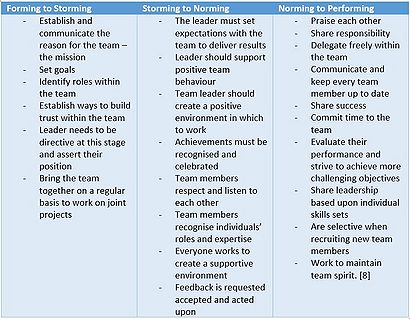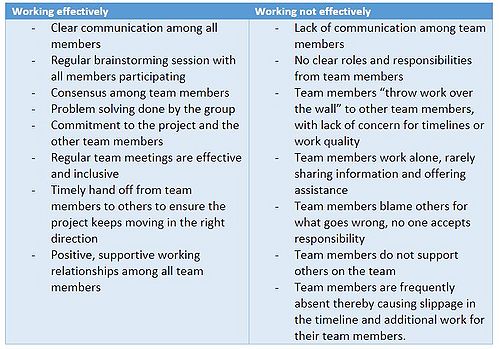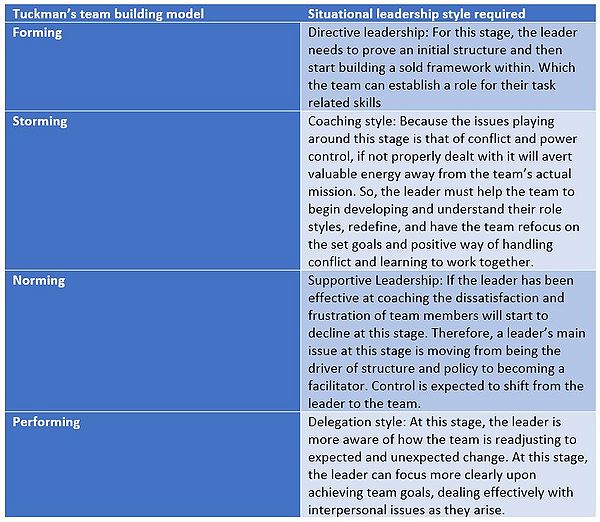Applying Tuckmans model for team development
Contents |
Abstract
A team can be defined as a group of individuals who work together to achieve a common goal. This is defined by Professor Thomson of the Kellog School of management as he states that “[a] team is a group of people who are interdependent with respect to information, resources, knowledge and skills and who seek to combine their efforts to achieve a common goal" ".[1].
This definition makes a team quite different from a group. An example of a team is a football team is a team working together towards a common goal. It is individuals who are interdependent, this means that the work needs to be a joint effort and synergy effects emerge. Whereas groups are independent individuals who are put together, here they interact and exchange information to achieve a particular goal, this has been defined by Robbins and Judge (2009). 2. [2]. Here it is clear who did what part of the project and the result is the sum of the work of each individual.
When a team is formed it goes through a maturity stage which can be described with the Tuckman’s model, also known as the “Form-Storm-Norm-Perform" (FNSP)-model which was introduced and determined in 1956 [3].
Tuckman’s model can be applied to crack the code of understanding how teams behave, and what to expect during the process. Before they can reach a high-level performance and until the end where they reach their common goal. Teamwork is not something that can be forced, it needs time to evolve, to get to its full potential. This can only be done by letting the team members get to know each other and go from strangers to co-workers, which makes the work more effective at the end, due to mutual understanding and respect.
The stages of Tuckmans model

The Tuckmans model, also known as the “Form-Storm-Norm-Perform”(FNSP)-model was first proposed and introduced in 1956 by Bruce Tuckman [3]. here he states that there are stages that teams goes through, which are necessary and cannot be avoided in order for the team to develop and face up to the given challenge. “The following model is offered as a conceptualization of changes in group behaviour, in both social and task realms, across all group settings, over time.” [5]. This will enable them to tackle different problems, better planning, finding results and in the end get results to reach their common goal. This will make the team more effective, give them more stability and mature over time, this however can be at different rates, which is stated in most bibliographic sources [6]., [7]., [8]., [9]. ".
Forming In the stages of forming the team is assembled and put together, this is also commonly known as the honeymoon phase because everyone is usually on their best behavior. Here the team gets to know each other, discuss, and agree on how to handle future conflicts among the team members. Here a group contract will emerge on how to handle challenges, opportunities, and expectations are set to reach the common goal. At the same time, the scope of the project is discussed, defined, concerns, and how to approach the scope. Roles are also usually given during this phase by the project manager.
Storming The second stage is the storming. This phase can also be defined as where disorder, confusion, and crisis appear. The members as been assigned different roles and statutes along the way and conflicts start to rise with it. “Group members become hostile toward one another and toward a therapist or trainer as means of expressing their individuality and resisting the formation of group structure.” ". [5]. This is due to the team are starting to sort itself and with it comes trust issues and airing different opinions among the members, where everyone might not be agreeable. The individual team members might realize that the task at hand is not as simple as they had thought, and the prioritization of the project and leadership be questioned.
Norming Once the storming is over and the dust has settled, the team enters the norming stage. Here everyone has evolved and learned to adapt to the team. “…conflicts are resolved and some degree of unity emerges. In the norming stage consensus develops around who the leaders are, and individual member’s role” [6]. Here the team will increase in performance and will move their focus to the task at hand so that the team is able to reach the common goal.
Performing The last stage the performing stage. Is the most efficient stage of the progress. It is also known as the stage where the team reaches a high-performance, hence the name “performing”. Here the team is cooperating, matured, organized, and reached a form of synergy. There is now a clear and stable working structure and the team members can acknowledge strengths and weaknesses among the members. The workload has also been optimized by dividing and being flexible with the responsibilities between the members. This also means that the team can resolve conflicts more efficiently than before, due to implementation and make changes to move onwards with the project. Milestones are also celebrated which also motivates the members to work more efficiently.
Applying Tuckmans model for team development

Teamwork is not something that just can be switched on, it is an effort that must come from all team members. But using Tuckmans model can make it easier to decipher the phase that the team is in and how-to handle the situation in the best way possible. This way the project manager can make the team more effective and deliver a high-performance result. During the forming stage, it is advised for the project manager to investigate the qualifications of each team member. How can they best contribute to the team to work most effectively and reach the common goal. Personality tests can also be advised to better secure the communication, workflow, and acceptance of roles on the team “…. The team members are very excited to meet each other. Each of them has heard of one another, although they have not worked together as a team before. They believe they each bring value to this project” [11]. This however will not necessarily prevent the storming phase but might make it shorter and more manageable for the project manager. In this stage, its orientation and getting to know the team members is important for the morality and cooperation of the team. Due to the different personalities and different work styles, it is unavoidable to not experience power struggle and conflicts. They will appear due to opinions and frustrations when working with the project. Here it is important to handle the conflicts, instead of trying to ignore them. Here the team needs to be able to seek help from the project manager to resolve conflicts. [6]. A way to make the team more effective and create a better understanding and cooperation is to make workshops. Small tasks that are easily managed and strengthens the bond and trust between members. “The group must feel safe putting forward ideas. To build team trust try, asking for help on tasks. That way you’ll encourage people to reflect on what they can offer and what they need from other team members.” 9. [12]. This way they can get past the team conflicts and move on to the stage of Norming. The social connections between team members might open for more possibilities and encourage them to support each other. This stage is crucial to move past, if not, the team may end up having a plan that is less effective to reach the common goal because they are to focus on consensus. This means that at this stage, the team can either be made and move on or be broken and may not recover. In some extreme cases, the team can be stuck in the storming phase. Here a one-on-one with the project manager, to review the goals and take responsibility for the members of the team, could be the solution to move on. [13].
If the team gets past the conflicts and enters the norming stage, the cohesion returns, and the members can agree on rules, plans, processes, and values with the help of the project manager. Here it is important to create a positive environment for teamwork, this enhances the workflow and gives the members opportunity to recognize individual expertise and a natural synergy might emerge. Which makes them enter the performing stage. When the team is at the performing stage the team will become more effective, and one might feel that there is no more to contribute as a project manager. But that is quite the opposite, engage the team members and boost them by delegating tasks and celebrate milestones.
Effective or not Work efficiency in a team is important for not only reaching the common goal, but also for the progress of how fast and what kind of result can come out of the team. There can be different indicators on whether a team is effective or not with their work. Some characterizations of whether or not a team is effective an successful can be set up as following in table 2. [11].

Limitations and challenges in Tuckmans model
The Tuckman’s model have been used for decades as a management tool for the development of teams, but like many other tools it has it’s challenges. Some of them where identified by Tuckman in 1965 where he states that “First this literature cannot be considered truly representative of small-group developmental processes, since certain settings have been overrepresented….”[4]. The setting is not the only challenges when managing a team since not all teams and team members are alike. Many factors can have an influence on how the team might have challenges and how Tuckman’s model might not a road from a to b. A diverse group can be a challenge since different personalities and cultures can have an influence on the team development and the cooperation of the team. “culture is more often a source of conflict than of synergy; cultural differences are a nuisance at best and often a disaster” [12] [14].
To manage a diverse group, it is necessary to develop and implement different strategies other than Tuckman’s model. In that sense that the project manager might have to adapt to the different roles during the different stages to accommodate the team’s needs. This way the progress can run a bit more smoothly, and one is able to handle the different situations and ensure team and organizational success see table 3.

not finished - in progress
Further Developments
Adjourning The last stage was not originally a part of the model from 1956 but was added jointly with Mary Ann Jensen in 1977 [15].. The adjourning stage is the stage of ending and departure. This is the final stage of the team development, also the end of the project. Here there is usually linked to more stress, due to the deadline of the project is nearing and most likely new projects starting up. There is however also a cause of celebration when all the work has been handed in and the common goal has been reached. Here the team also evaluates their work and takes everything they have learned in the teams with them to the next project. When the project ends the people in the teams typically disappear along with the project.
Norming and re-norming
in progress
Annotated Bibliography
- Judith Stein - Using the stages of Team Development (2021)
- Alex Jonas - The Tuckman's model implementation, effect, and analysis & the new development of jones LSI model on a small group (2019)
in progress
References
- ↑ Thompson, Leigh L : Free Download, Borrow, and Streaming, Internet Archive (2021). [1]. Retrieved 06 February 2021.
- ↑ S. P. Robbins, T. A. Judge pdf, pdf P. Stephen Robbins, and T. A. Judge (13th Edition).
- ↑ 3.0 3.1 W. G. Bennis and H. A. Shepard, Hum. Relations, vol. 9, no. 4, pp. 415–437, Nov. 1956.
- ↑ 4.0 4.1 B. Tuckman: Psychological Bulletin (1956). Archived: [2]. Retrieved 18 February 2021.
- ↑ 5.0 5.1 B. W. Tuckman (1965).
- ↑ 6.0 6.1 6.2 . Archived: [3] Retrieved 19 February 2021.
- ↑ . D. Rowley and M. Lange: Archived: [4] Retrieved 19 February 2021.
- ↑ . D. Rowley and M. Lange 2007.
- ↑ A. JONES : J. Manage., vol. 6, no. 4, Aug. 2019.
- ↑ University of Glasgow, (2021). [Available: https://www.gla.ac.uk/media/Media_358180_smxx.pdf.]. Retrieved 21 February 2021.
- ↑ 11.0 11.1 11.2 CanadaTeam, Quickbooks (2021). G. Abudi, 2010 [Available: https://www.projectsmart.co.uk/the-five-stages-of-team-development-a-case-study.php. ]. Retrieved 06 February 2021.
- ↑ The Mind Tools Content Team, (2021). [5]. Retrieved 21 February 2021.
- ↑ The Team Building Company [6]. Retrieved 21 February 2021.
- ↑ 14.0 14.1 G. Essien, (2015) [7]. Retrieved 21 February 2021.
- ↑ B. W. Tuckman and M. A. C. (Original: 1977): Gr. Facil. A Res. Appl. J., no. 10, pp. 43–48, 2010.